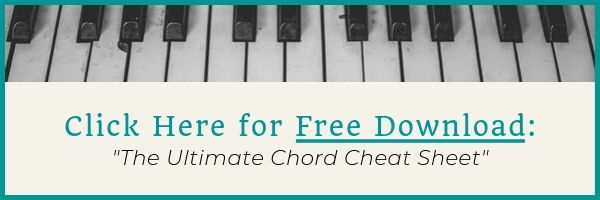A7 Piano Chord: Notes & How to Play It
The A7 piano chord is a seventh chord or more technically known as a dominant seventh chord. A7 chord is a pretty common to run across and a good one to remember the notes of.
So here we will learn:
- the notes of the A7 piano chord
- finger positions for A7
- how to play the A7 chord
- A7/C# chord
- A7sus4 chord
- and a bit of theory to top things off
A7 Piano Chord Notes
The A7 chord is made up of 4 notes: A, C#, E, and G.
You can play these notes in either the right hand or the left hand - it depends on your playing style at the moment.
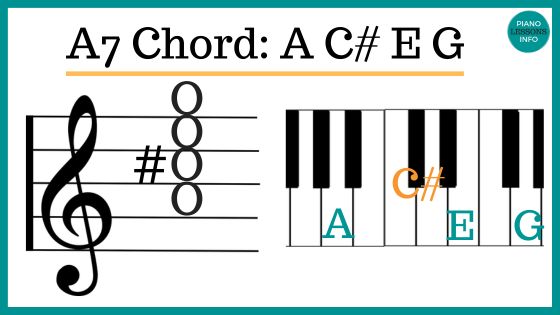
Here are some options for playing the A7 chord:
- play all the notes in your left hand (together or one at a time)
- play all the notes in your right hand and play just A in your left hand
- play the melody in your right hand while adding in notes of the chord below the melody and focusing on bass notes in the left hand.
How to Play A7 Chord
This video will show you how to play the A7 chord and also how it should sound.
Finger Positions for A7 Chord
You can play the A7 chord with the same fingering you use for other 4-note chords.
In your right hand:
- use your thumb / finger 1 on A
- index / finger 2 on C#
- ring finger / finger 4 on E
- pinkie / finger 5 on G
In your left hand:
- use your pinkie / finger 5 on A
- ring finger / finger 4 on C#
- index / finger 2 on E
- your thumb / finger 1 on G
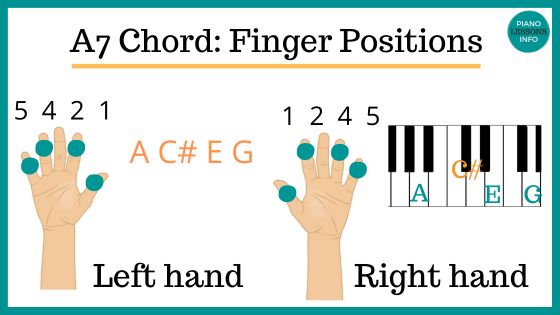
4 note chords like A7 have the tendency to feel uncomfortable when you first play them. If this is the case for you, the more you practice, the more comfortable it will get. This may just feel like a bit of stretching in your hands at first.
Piano Inversions for A7
Sometimes it is easier to play 7th chords in inversions.(If you don't know much about inversions, here is some more information.)
Here are the inversions for A7:
Root position: A C# E G
1st inversion: C# E G A
2nd inversion: E G A C#
3rd inversion: G A C# E
You can use the fingers 1, 2, 4 and 5 for most of these inversions but I'd recommend switching to 1, 3, 4, and 5 or the second inversion.
More Common Types of A7 Chords
There are a few other chords that are somewhat common and use A7 for a base.
A7sus4 Piano Chord
The A7sus or A7sus4 chord is basically the Asus / Asus4 chord plus that lowered 7th note.
Asus = A D E
When you add the lowered 7th - G - you get all the notes of the A7sus4: A D E G.
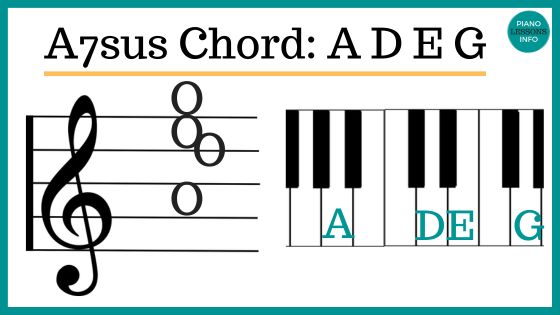
This is a suspended 7th or suspended dominant seventh chord.
A7/C# Chord
Another chord that is pretty common is A7/C#. With this chord, you play all the notes of the A7 chord. That part you've learned already.
What you see after the slash - C# - is what you need to play in your left hand as the lowest note. C# is you bass note.
This would apply to any other slash chord you see - A7/G or A7/E. The notes after the slash are the bass notes for the left hand. This is what makes inversions so great to practice because you get used to playing these chords in different positions.
A7 Piano Chord Key & Some Chord Theory
If you don't understand the chord theory behind 7th chords, this is a great time to learn a little. The A7 chords isn't really in the key of A. It is the dominant seventh chord and dominant means 5. It's the 5 chord in another key and that's the key of D. (D - E - F# - G - A.)
But that is usually not the easy way to figure out a chord like A7. You can also use the chord formula for 7th chords: 1, 3, 5, b7. Then apply that to the A major scale.
The numbers of the formula refer to where to find the note on the major scale.
Take the A major scale below:
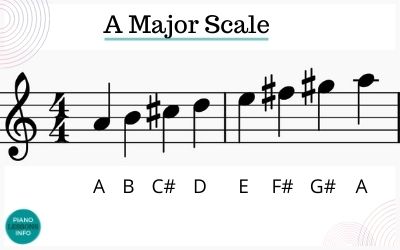
If the chord formula is 1, 3, 5, b7, it works like this:
1 = A (first note of the major scale)
3 = C#
5 = E
b7 = G (lowered from G#)
So the notes of A7 are A, C#, E, G.
Free Download:
Ultimate Chord Cheat Sheet

Subscribe below and get free access to the (printable) Ultimate Chord Cheat Sheet.
A7 Chord FAQ
1. What is the A7 piano chord?
1. What is the A7 piano chord?
A7, also known as A dominant 7th, is a four-note chord that consists of A, C#, E, and G. This chord is widely used in genres such as blues, jazz, and pop.
2. How do I play the A7 chord on the piano?
2. How do I play the A7 chord on the piano?
You play the A7 chord by pressing the A, C#, E, and G keys at the same time. However, the exact positioning of these notes can change based on the inversion of the chord you are playing.
3. What is the difference between A7 and Am7 chords?
3. What is the difference between A7 and Am7 chords?
The main difference between these two chords is the third note. A7 uses a major third (C#), while Am7 uses a minor third (C), changing the overall tonality of the chord.
4. What does 'dominant' mean in music theory?
4. What does 'dominant' mean in music theory?
In music theory, 'dominant' often refers to the fifth note or chord in a key's major scale. It's called 'dominant' because it 'dominates' or strongly resolves to the tonic, which is the first note or chord of the scale.
5. Can I play inversions of the A7 chord?
5. Can I play inversions of the A7 chord?
Yes. There are some inversions that will feel more comfortable to you potentially and playing those in the right hand is no problem. In the left hand you do want to keep in mind that A should be the lowest note unless otherwise noted and adjust to make that the main note you hear in the left hand.
6. Why do some music sheets have 'A7' written on them?
6. Why do some music sheets have 'A7' written on them?
The 'A7' notation on music sheets indicates that you should play an A dominant 7th chord at that point in the song. It helps musicians understand the harmonic context of the piece they're playing.
7. How does the A7 chord sound?
7. How does the A7 chord sound?
The A7 chord has a distinct, slightly dissonant sound that can create tension in a musical piece. This tension often seeks resolution, which makes A7 a popular choice for transitions to the tonic chord in a piece.
8. Where is the A7 chord commonly used?
8. Where is the A7 chord commonly used?
The A7 chord is frequently used in many genres of music, including blues, jazz, rock, and pop. It's often found in songs with a strong harmonic progression, serving as a transition or 'pivot' chord.
9. Is it necessary to play all the notes in the A7 chord?
9. Is it necessary to play all the notes in the A7 chord?
Not always. Sometimes, for simplicity or due to the context of the song, musicians might opt to play a simplified version of the A7 chord, often excluding the 5th (E). This is still considered an A7 chord as the dominant 7th (G) and major 3rd (C#) define its character.
10. I'm a beginner. Is the A7 chord hard to learn?
10. I'm a beginner. Is the A7 chord hard to learn?
With practice, any chord can be learned and mastered, including the A7 chord. The difficulty may vary based on the person's existing musical knowledge and their finger dexterity. But, with consistent practice, it is very achievable.
Recent Articles
-
Piano Notes Chart
Nov 20, 23 10:21 PM
Find a piano notes chart for treble clef and bass clef notes as well as the different types of notes. -
D Chord on Piano + Diagram, How To & Theory
Oct 24, 23 12:20 AM
Learn how to play the D chord on piano with diagram, fingering, D/A, D/F# and a theory explainer. -
Diminished Piano Chords: Chart & How to Make Them
Oct 09, 23 09:23 PM
Learn the different diminished piano chords and how to make them. Here you'll find both a diminished chord chart and an explanation.
- Home
- 14 Day Chord Challenge
- A7 Piano Chord
Free Download:
Ultimate Chord Cheat Sheet

Subscribe below and get free access to the (printable) Ultimate Chord Cheat Sheet.

